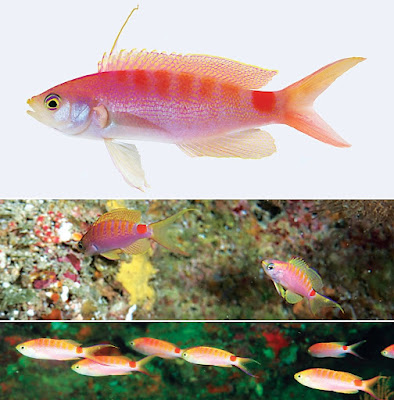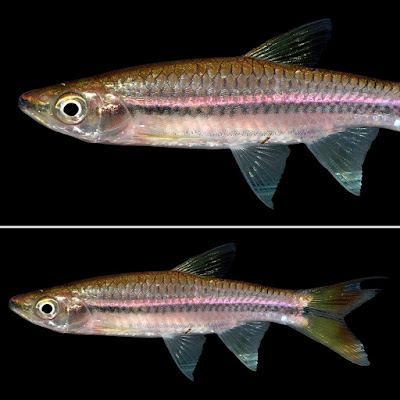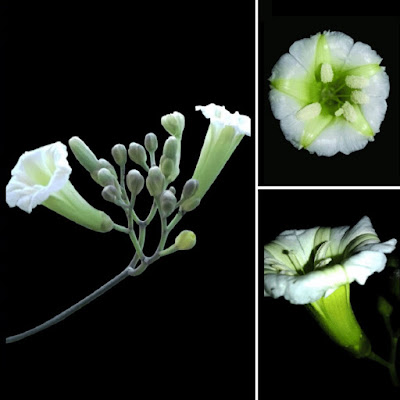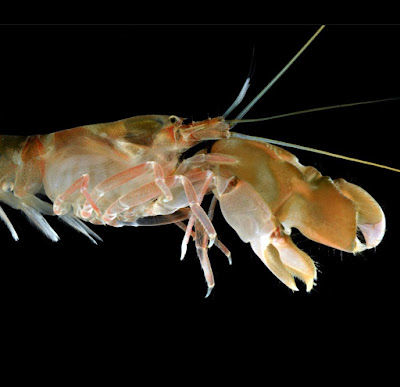[Most Recent Entries] [Calendar View]
Tuesday, September 29th, 2020
| Time | Event | ||||||||||
| 2:02a | [Ichthyology • 2020] Pseudanthias timanoa • A New Fairy Basslet (Serranidae: Anthiadinae) from New Caledonia, South Pacific
Abstract A new fairy basslet, Pseudanthias timanoa n. sp., is described from 21 specimens, 50.0-79.1 mm SL, collected recently from New Caledonia, in the southwestern corner of the tropical Pacific Ocean. The new species is typically found on deep coral-reef slopes, at depths of 50-100 m. One of many slender, brightly colored fairy basslets found throughout the Indo-West Pacific Ocean, P. timanoa is part of the Pseudanthias lori species complex. It is distinguished from its congeners by the live color pattern, which is bright reddish pink with a series of 7 red-orange bars along the upper body followed by a deeper-red rectangular saddle on the caudal peduncle. Mature males develop a greatly elongated third dorsal-fin spine, up to about 1.5 times head length and long, trailing caudal-fin filaments. The sequence of the mtDNA barcode marker COI for the new species is 10.3% divergent (p-distance) from the nearest relative in the Barcode of Life Database, P. lori, from the Coral Sea and Philippines. The new species appears in the aquarium trade as the Sunrise Anthias. With this discovery, there are now 16 species of Pseudanthias documented from New Caledonia. Key words: taxonomy, ichthyology, coral-reef fishes, DNA barcoding, goldies, Sunrise Anthias.
Pseudanthias timanoa, Victor, Teitelbaum & Randall Sunrise Anthias Pseudanthias timanoa with incorrect authorship “Randall, 2014”, a nomen nudum until the present description, Laboute & Grandperrin 2016: 217, fig. a single photograph (without any description in the text, and based on no description, publication, or collected specimen). Diagnosis. A species of Pseudanthias with dorsal-fin elements X,15 or 16 (most 16), third spine greatly elongated in mature males, up to about 1.5 times head length, 2.2 in SL, up to three times length of next spines; anal-fin elements III,7; pectoral-fin rays 18 or 19 (most 19); caudal fin deeply lunate with filamentous tips in mature males (eroded away in aquarium specimens), maximum caudal concavity 3.1 in SL in intact paratype; body elongate, body depth 3.4 (3.2–4.0) in SL; head and body reddish pink with 7 red-orange bars along upper body followed by a deeper-red, saddle-like rectangle on caudal peduncle. Etymology. The new species is named timanoa, a euphonious amalgamation of the second author’s three children’s names: Timothée, Maëlle, and Noa. The specific epithet is treated as a noun in apposition. Benjamin C. Victor, Antoine Teitelbaum and John E. Randall. 2020. Pseudanthias timanoa, A New Fairy Basslet from New Caledonia, South Pacific (Teleostei: Serranidae: Anthiadinae). Journal of the Ocean Science Foundation. 36, 6-15. DOI: 10.5281/zenodo.4050419 | ||||||||||
| 2:06a | [Ichthyology • 2020] Rasbora marinae • A New Species of Cyprinid Fish (Cypriniformes: Danionidae) from northwestern Borneo
Abstract Rasbora marinae, new species, is described from Brunei Darussalam and northern Sarawak, Borneo. It shares with R. cephalotaenia the colour pattern of a mid-lateral stripe from tip of snout to end of median caudal-fin rays and rows of black spots on the flank, including two rows along edges of the mid-lateral stripe; it differs from R. cephalotaenia in retaining the mid-lateral stripe in adults, and in the absence of a conspicuous black blotch at the middle of the caudal-fin base. Key words. Southeast Asia, biodiversity, taxonomy, Cypriniformes, peat swamps
Rasbora marinae, new species Diagnosis. Rasbora marinae is differentiated from congeners by the following combination of characters: a mid-lateral black or dark brown stripe from the tip of the snout to the end of the median caudal-fin rays; rows of black spots on the flank, including two rows along the edges of the midlateral stripe; lateral line complete, with 30–31 + 1–2 scales; 12 circumpeduncular scale rows. Rasbora marinae is very similar to R. cephalotaenia from which it differs in retaining the mid-lateral stripe in adults (vs. stripe disappearing with increasing size, leaving only the 2 rows of black spots along its edges), and the absence of a conspicuous black blotch at the middle of the caudal-fin base (vs. presence). Distribution. Rasbora marinae is currently found in Belait and Tutong Districts, Brunei Darussalam; and in Sarawak, north of Tatau basin including Lambir Hills, to Baram basin (see map in Fig. 6; Zakaria-Ismail, 1984; Parenti & Meisner, 1995; Sulaiman & Shahdan, 2003; Tan & Lim, 2007; unpublished data). Etymology. This species is named for Marina Wong (Brunei Museum, retired) in appreciation of her contributions to the knowledge of the natural history of Southeast Asia and her generous help in organising fieldwork in Brunei for the first author and team. Tan Heok Hui and Maurice Kottelat. 2020. Rasbora marinae, A New Species of Cyprinid Fish from northwestern Borneo (Teleostei: Danionidae). RAFFLES BULLETIN OF ZOOLOGY. 68: 750–758. DOI: 10.26107/RBZ-2020-0086 | ||||||||||
| 7:55a | [Botany • 2020] Ipomoea vespertilia (Convolvulaceae) • A New Species endemic to Northeast Brazil; revealed by Pollinator Observation
Abstract A new and endangered species, endemic to dry forests of the Caatinga Domain in Northeast Brazil is described and illustrated. Ipomoea vespertilia has been misidentified in herbaria as I. marcellia, to which it appears to be closely related. However, it differs consistently from that species in multiple morphological characters and the timing of anthesis. Keywords: Anthesis, biodiversity, Brazilian flora, cytotaxonomy, integrative taxonomy
Ipomoea vespertilia D. Santos, G. C. Delgado-Junior & Buril, sp. nov. Etymology.—The specific epithet “vespertilia” is a reference to the main floral visitors, bats (Phyllostomidae). Francisco Diego Sousa Santos, Geadelande Carolino Delgado Junior, Mariana Báez, Andrea Pedrosa-Harand, Joel Araújo Queiroz, Zelma Glebya Maciel Quirino, Isabel Cristina Machado and Maria Teresa Buril. 2019. Ipomoea vespertilia (Convolvulaceae), A New Species revealed by Pollinator Observation. Brittonia. 71, 190–195. DOI: 10.1007/s12228-018-09565-6 Resumo: É descrita uma nova espécie ameaçada de extinção e endêmica do domínio da Caatinga, Nordeste do Brasil. Ipomoea vespertilia estava incorretamente identificada nos herbários como I. marcellia, com a qual parece ser proximamente relacionada. No entanto, além de diferenças morfológicas consistentes, é reconhecida por um período de antese distinto. | ||||||||||
| 8:18a | [Crustacea • 2020] Taxonomic Notes on Alpheus inopinatus Holthuis & Gottlieb, 1958 and Alpheus cf. lobidens De Haan, 1849 (Malacostraca: Decapoda: Alpheidae) from Kuwait
Abstract The status of the common intertidal snapping shrimp, Alpheus inopinatus Holthuis & Gottlieb, 1958, is discussed based on newly collected material from Kuwait. Alpheus inopinatus was previously confused with morphologically very similar species in the Alpheus lobidens De Haan, 1849 species complex, formerly identified as A. crassimanus Heller, 1862 and herein tentatively referred to as A. cf. lobidens. The material herein examined strongly supports the validity of A. inopinatus based on several morphological characters, as well as differences in the colour pattern, compared to other members of the A. lobidens complex. Keywords: Crustacea, Alpheus, Alpheidae, snapping shrimp, Indian Ocean, Arabian-Persian Gulf
Arthur Anker, Manal Al-Kandari and Sammy De Grave. 2020. Taxonomic Notes on Alpheus inopinatus Holthuis & Gottlieb, 1958 and Alpheus cf. lobidens De Haan, 1849 from Kuwait (Malacostraca: Decapoda: Alpheidae). Zootaxa. 4851(1); 189–197. DOI: 10.11646/zootaxa.4851.1.10 |
| << Previous Day |
2020/09/29 [Calendar] |
Next Day >> |
















